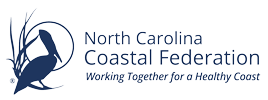
The Mattamuskeet Drainage Association is working with the N.C. Coastal Federation, researchers from N.C. State University and other stakeholders to carry out a watershed restoration plan that was developed with a grant from the N.C. Division of Water Quality. These partners recognize the need to reduce the volume of drainage water that is pumped into shellfish waters. The networks of canals and ditches throughout the drainage association and the nearby gamelands transport naturally occurring bacteria to the Pamlico Sound. This voluntary plan identifies specific projects that reduce the amount of water pumped into coastal waters, and at the same time provides for improved water-management for agriculture, forestry, and wildlife.

This fact sheet details the importance of the Carteret County Community College Living Shoreline as well as the Bogue Sound area in general. It provides information on how the Federation and the community college are working together to protect and create habitat, prevent erosion, and improve water quality.

This Fact Sheet provides information on the NC Coastal Federation's joint efforts with Airlie Gardens, NOAA's Community-based Restoration Program, and Restore America's Estuaries. This project's goal is to link coastal habitat restoration with environmental education efforts in NC's southeastern coastal region.

Step back in time when you visit the Coastal Federation’s Hoop Pole Creek preserve in the middle of Atlantic Beach. Known as the “central park” of this resort town, this preserved 31-acre maritime forest is about one percent of the town and about all that’s left of its natural environment outside the borders of a state park.

This fact sheet details the 600-acre pilot project that was completed in 2010 by the NC Coastal Federation on Mattamuskeet Ventures Farm. This project was developed to reduce agricultural runoff into various water ways while also offsetting salt water infiltration issues faced by farmers in the region.

This fact sheet details the overarching issues in the Stump Sound watershed as well as the degradation to Morris Landing caused by unregulated use. This resource explain how the conservation easement, living shoreline, and on going volunteer work are restoring the area while preserving it for future use.
